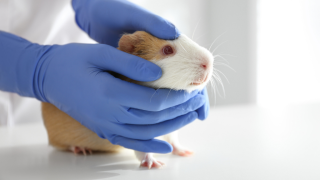
USDA increases transparency with public release of 2021-2023 animal testing data
The U.S. Department of Agriculture (USDA) has finally restored a degree of transparency to its reporting of animals used in experiments, which reveals a meagre 1% fall in 2023 – and an alarming 9% increase in experiments which cause the most pain and suffering to animals.
Latest figures show that, using the USDA criteria of recording the use of animals in science, 649,159 animals were used in experiments across the U.S. in 2023, including 42,295 dogs, 13,005 cats, 65,823 monkeys, 167,672 guinea pigs, 114,768 rabbits and 3,097 horses.
The report also reveals that an additional 124,906 animals were bred and held in laboratories in 2023 but were not used in experiments, 34% of which were monkeys. This brings the total number of animals used for scientific purposes in the U.S. in 2023 to 774,065 animals, a 1% fall from the 2022 total of 784,295.
USDA figures also do not include the use of mice, rats, fish, or birds, which are the most commonly used animals in experiments. As a result, we estimate that the actual number of animals used for scientific procedures in the U.S. each year will exceed 14 million, making it the third-largest user of animals globally, behind China and Japan.
Most concerning is the increase in Category E experiments, which involve procedures that cause pain or distress without any relief for the animals. In 2023, 62,241 animals were subjected to such tests, marking a 9% rise from the previous year. Guinea pigs (47%) and hamsters (34%) were the most frequently used species in these painful experiments. Alarmingly, other species also saw significant increases, with dogs (up by 20%), cats (up by 51%), monkeys (up by 29%), and horses (up by 26%) all subjected to more painful procedures in 2023.
Our Deputy Director of Science and Regulatory Affairs, Laura Alvarez said, “These findings underscore the ongoing ethical concerns surrounding animal experimentation in the United States. The troubling rise in painful procedures, combined with the over-reliance on animal testing, highlights the urgent need for stricter regulations, greater transparency, and a commitment to developing and adopting alternative testing methods that do not involve causing suffering to animals.”
Following the release of the 2021 data in 2023, we requested an explanation from the USDA regarding the change in how data was published. The 2021 data was the first to be presented in a new and more difficult to digest format, which made analysis against previous years very difficult when trying to compare state and national totals, or compare by species and pain categories.
We received no response. We are, though, still thankful for the support of several members of Congress, who shared our concerns and co-signed a letter to the USDA, urging them to clarify the issue and stressing the importance of providing the public with timely summary reports.
Shortly after this inquiry, the 2021, 2022 and 2023 data were published with national totals broken down by species and pain categories. Summaries of state totals are still not provided but can be tallied by sorting through thousands of individual laboratory reports that are available to the public. Archived summary reports for all previous years were removed.
Monica Engebretson, our North America Head of Public Affairs, said, “We are pleased that some transparency has been restored in the reporting of annual animal use numbers. Providing a summary of the data alongside individual totals is just as important as making the raw data available. Abandoning the traditional summary reports under the pretext of increasing public transparency, through access to thousands of individual annual reports, was unacceptable. It appeared more like a sleight of hand by the agency, ultimately clouding the broader picture of animal use from year to year. Timely and coherent annual reports on the number of animals used in Animal Welfare Act-licensed facilities are a fundamental taxpayer funded responsibility.”
If you live in the United States, you can help us hold agencies and facilities accountable by joining our mailing list.
